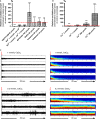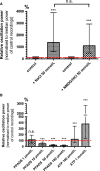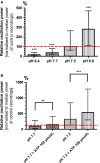High-frequency voltage oscillations in cultured astrocytes
- PMID: 25969464
- PMCID: PMC4463829
- DOI: 10.14814/phy2.12400
High-frequency voltage oscillations in cultured astrocytes
Abstract
Because of their close interaction with neuronal physiology, astrocytes can modulate brain function in multiple ways. Here, we demonstrate a yet unknown astrocytic phenomenon: Astrocytes cultured on microelectrode arrays (MEAs) exhibited extracellular voltage fluctuations in a broad frequency spectrum (100-600 Hz) after electrical stimulation. These aperiodic high-frequency oscillations (HFOs) could last several seconds and did not spread across the MEA. The voltage-gated calcium channel antagonist cilnidipine dose-dependently decreased the power of the oscillations. While intracellular calcium was pivotal, incubation with bafilomycin A1 showed that vesicular release of transmitters played only a minor role in the emergence of HFOs. Gap junctions and volume-regulated anionic channels had just as little functional impact, which was demonstrated by the addition of carbenoxolone (100 μmol/L) and NPPB (100 μmol/L). Hyperpolarization with low potassium in the extracellular solution (2 mmol/L) dramatically raised oscillation power. A similar effect was seen when we added extra sodium (+50 mmol/L) or if we replaced it with NMDG(+) (50 mmol/L). The purinergic receptor antagonist PPADS suppressed the oscillation power, while the agonist ATP (100 μmol/L) had only an increasing effect when the bath solution pH was slightly lowered to pH 7.2. From these observations, we conclude that astrocytic voltage oscillations are triggered by activation of voltage-gated calcium channels and driven by a downstream influx of cations through channels that are permeable for large ions such as NMDG(+). Most likely candidates are subtypes of pore-forming P2X channels with a low affinity for ATP.
Keywords: Calcium channels; Glia; HFO; MEA; P2X channels; extracellular recording; multi‐electrode array; voltage oscillations.
© 2015 The Authors. Physiological Reports published by Wiley Periodicals, Inc. on behalf of the American Physiological Society and The Physiological Society.
Figures










Similar articles
-
Stimulus-evoked high frequency oscillations are present in neuronal networks on microelectrode arrays.Front Neural Circuits. 2012 May 15;6:29. doi: 10.3389/fncir.2012.00029. eCollection 2012. Front Neural Circuits. 2012. PMID: 22615686 Free PMC article.
-
Mechanisms for L-channel-mediated increase in [Ca(2+)]i and its reduction by anti-bipolar drugs in cultured astrocytes combined with its mRNA expression in freshly isolated cells support the importance of astrocytic L-channels.Cell Calcium. 2013 Nov;54(5):335-42. doi: 10.1016/j.ceca.2013.08.002. Epub 2013 Aug 19. Cell Calcium. 2013. PMID: 24079970
-
Cellular mechanism for spontaneous calcium oscillations in astrocytes.Acta Pharmacol Sin. 2006 Jul;27(7):861-8. doi: 10.1111/j.1745-7254.2006.00397.x. Acta Pharmacol Sin. 2006. PMID: 16787570
-
Voltage-gated cation and anion channels in mammalian Schwann cells and astrocytes.J Physiol (Paris). 1987;82(4):248-57. J Physiol (Paris). 1987. PMID: 2460619 Review.
-
Electrophysiology of islet cells.Adv Exp Med Biol. 2010;654:115-63. doi: 10.1007/978-90-481-3271-3_7. Adv Exp Med Biol. 2010. PMID: 20217497 Review.
Cited by
-
Phenotypic Screening of Prospective Analgesics Among FDA-Approved Compounds using an iPSC-Based Model of Acute and Chronic Inflammatory Nociception.Adv Sci (Weinh). 2024 Mar;11(11):e2303724. doi: 10.1002/advs.202303724. Epub 2024 Jan 8. Adv Sci (Weinh). 2024. PMID: 38189546 Free PMC article.
-
Ultrasensitive gold micro-structured electrodes enabling the detection of extra-cellular long-lasting potentials in astrocytes populations.Sci Rep. 2017 Oct 27;7(1):14284. doi: 10.1038/s41598-017-14697-y. Sci Rep. 2017. PMID: 29079771 Free PMC article.
-
And yet it moves: Recovery of volitional control after spinal cord injury.Prog Neurobiol. 2018 Jan;160:64-81. doi: 10.1016/j.pneurobio.2017.10.004. Epub 2017 Nov 2. Prog Neurobiol. 2018. PMID: 29102670 Free PMC article. Review.
-
Electrically-evoked oscillating calcium transients in mono- and co-cultures of iPSC glia and sensory neurons.Front Cell Neurosci. 2023 Mar 16;17:1094070. doi: 10.3389/fncel.2023.1094070. eCollection 2023. Front Cell Neurosci. 2023. PMID: 37006467 Free PMC article.
-
Extracellular Electrophysiological Measurements of Cooperative Signals in Astrocytes Populations.Front Neural Circuits. 2017 Oct 23;11:80. doi: 10.3389/fncir.2017.00080. eCollection 2017. Front Neural Circuits. 2017. PMID: 29109679 Free PMC article.
References
-
- Akita T, Fedorovich SV. Okada Y. Ca2+ nanodomain-mediated component of swelling-induced volume-sensitive outwardly rectifying anion current triggered by autocrine action of ATP in mouse astrocytes. Cell. Physiol. Biochem. 2011;28:1181–1190. - PubMed
-
- Anderson CM, Bergher JP. Swanson RA. ATP-induced ATP release from astrocytes. J. Neurochem. 2004;88:246–256. - PubMed
LinkOut - more resources
Full Text Sources
Other Literature Sources
Miscellaneous

